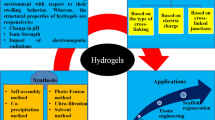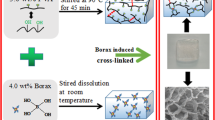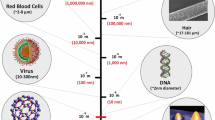Abstract
In this work, pH-sensitive hydrogel nanoparticles based on N-isopropyl acrylamide (NIPAM) and methacrylic acid (MAA) at various molar ratios, were synthesized and characterized in terms of physicochemical and biological properties. FTIR and 1HNMR spectra confirmed the successful synthesis of the copolymer that formed nanoparticles. AFM images and FE-SEM micrographs showed that nanoparticles were spherical, but their round-shape was slightly compromised with MAA content; besides, the size of particles tends to decrease as MAA content increased. The hydrogels nanoparticles also exhibited an interesting pH-sensitivity, displaying changes in its particle size when changes in pH media occurred. Biological characterization results indicate that all the synthesized particles are non-cytotoxic to endothelial cells and hemocompatible, although an increase of MAA content leads to a slight increase in the hemolysis percentage. Therefore, the pH-sensitivity hydrogels may serve as a versatile platform as self-regulated drug delivery systems in response to environmental pH changes.












Similar content being viewed by others
References
Khan MS, Khan GT, Khan A, Sultana S. Preparation and characterization of novel temperature and pH sensitive (NIPAM-co-MAA) polymer microgels and their volume phase change with various salts. Polymer. 2013;37:794–801. https://doi.org/10.7317/pk.2013.37.6.794.
Gao X, Cao Y, Song X, Zhang Z, Xiao C, He C, Chen X. pH- and thermo-responsive poly(N-isopropylacrylamideco-acrylic acid derivative) copolymers and hydrogels with LCST dependent on pH and alkyl side groups. J Mater Chem B. 2013;1:5578–87. https://doi.org/10.1039/c3tb20901f.
Caló E, Khutoryanskiy VV. Biomedical applications of hydrogels: a review of patents and commercial products. Eur Polym J. 2015;65:252–67. https://doi.org/10.1016/j.eurpolymj.2014.11.024.
Hajebi S, Rabiee N, Bagherzadeh M, Ahmadi S, Rabiee M, Roghani-Mamaqani H, Tahriri M, Tayebi L, Hamblin MR. Stimulus-responsive polymeric nanogels as smart drug delivery systems. Acta Biomaterialia. 2019;92:1–18. https://doi.org/10.1016/j.actbio.2019.05.018.
Wu Q, Tian P. Adsorption of Cu2+ ions with poly(N-isopropylacrylamide-co-methacrylic acid) Micro/Nanoparticles. J Appl Polym Sci. 2008;109:3470–6. https://doi.org/10.1002/app.28450.
Díez-Peña E, Frutos P, Frutos G, Quijada-Garrido I, Barrales-Rienda JM. The influence of the copolymer composition on the diltiazem hydrochloride release from a series of pH-sensitive poly[(N-isopropylacrylamide)-co-(methacrylic acid)] hydrogels. AAPS PharmSciTech. 2004;5:69–76. https://doi.org/10.1208/pt050233.
Zhang K, Wu XY. Temperature and pH-responsive polymeric composite membranes for controlled delivery of proteins and peptides. Biomaterials. 2004;25:5281–91. https://doi.org/10.1016/j.biomaterials.2003.12.032.
Tian P, Wu Q, Lian K. Preparation of temperature- and pH-sensitive, stimuli responsive poly(N-isopropylacrylamide-co-methacrylic acid) nanoparticles. J Appl Polym Sci. 2008;108:2226–32. https://doi.org/10.1002/app.27888.
Constantin M, Bucatariu S, Harabagiu V, Popescu I, Ascenzi P, Fundueanu G. Poly(N-isopropylacrylamide-co-methacrylic acid) pH/thermo-responsive porous hydrogels as self-regulated drug delivery system. Eur J Pharm Sci. 2014;62:86–95. https://doi.org/10.1016/j.ejps.2014.05.005.
Huang J, Wu XY. Effects of pH, salt, surfactant and composition on phase transition of poly(NIPAm/MAA) nanoparticles. J Polym Sci A. 1999;37:2667–76. https://doi.org/10.1002/(SICI)1099-0518(19990715)37:14%3C2667::AID-POLA42%3E3.0.CO;2-J.
South AB, Lyon LA. Direct observation of microgel erosion via in-liquid atomic force microscopy. Chem. Mater. 2010;22:3300–6. https://doi.org/10.1021/cm100702p.
Gordijo CR, Koulajian K, Shuhendler AJ, Bonifacio LD, Huang HY, Chiang S, Ozin GA, Giacca A, Wu XY. Nanotechnology-enabled closed loop insulin delivery device: In vitro and in vivo evaluation of glucose regulated insulin release for diabetes control. Adv Funct Mater. 2011;21:73–82. https://doi.org/10.1002/adfm.201001762.
Karg M, Pastoriza-Santos I, Rodriguez-González B, von Klitzing R, Wellert S, Hellweg T. Temperature, pH, and ionic strength induced changes of the swelling behavior of PNIPAM-Poly(allylacetic acid) copolymer microgels. Langmuir. 2008;24:6300–6. https://doi.org/10.1021/la702996p.
Zhang J, Peppas NA. Molecular interactions in poly(methacrylic acid)/poly(N-isopropyl acrylamide) interpenetrating polymer networks. J Appl Polym Sci. 2001;82:1077–82. https://doi.org/10.1002/app.1942.
Roach P, McGarvey DJ, Lees MR, Hoskins C. Remotely triggered scaffolds for controlled release of pharmaceuticals. Int J Mol Sci. 2013;14:8585–602. https://doi.org/10.3390/ijms14048585.
Jadhav SA, Brunella V, Miletto I, Berlier G, Scalarone D. Synthesis of poly(N-isopropylacrylamide) by distillation precipitation polymerization and quantitative grafting on mesoporous silica. J Appl Polym Sci. 2016;133:44181. https://doi.org/10.1002/app.44181.
Li W, Hu L, Zhu J, Li D, Luan Y, Xu W, Serpe MJ. Comparison of the responsivity of solution-suspended and surface-bound poly(N-isopropylacrylamide)-based microgels for sensing applications. ACS Appl Mater Interfaces. 2017;9:26539–48. https://doi.org/10.1021/acsami.7b05558.
López-Barriguete JE, Bucio E. Temperature-responsive copolymeric hydrogel systems synthetized by ionizing radiation. Radiat Phys Chem. 2017;135:113–20. https://doi.org/10.1016/j.radphyschem.2017.01.043.
Ribeiro CA, Martins MVS, Bressiani AH, Bressiani JC, Leyva ME, de Queiroz AAA. Electrochemical preparation and characterization of PNIPAM-HAp scaffolds for bone tissue engineering. Mater Sci Eng C Mater Biol Appl. 2017;81:156–66. https://doi.org/10.1016/j.msec.2017.07.048.
Evanghelidis A, Beregoi M, Diculescu VC, Galatanu A, Ganea P, Enculescu I. Flexible delivery patch systems based on thermoresponsive hydrogels and submicronic fiber heaters. Sci Rep. 2018;8:17555. https://doi.org/10.1038/s41598-018-35914-2.
Rasib SZM, Ahmad Z, Khan A, Akil HM, Othman MBH, Hamid ZAA, Ullah F. Synthesis and evaluation on pH- and temperature-responsive chitosan-p(MAA-co-NIMPAM) hydrogels. Int J Biol Macromol. 2018;108:367–75. https://doi.org/10.1016/j.ijbiomac.2017.12.021.
aithongdee A, Varanusupakul P, Imyim A. Preparation of thermally sensitive poly[N-isopropyl acrylamide-co-(maleic acid)] hydrogel membrane by electrospinning using a green solvent. Green Chem Lett Rev. 2014;7:220–7. https://doi.org/10.1080/17518253.2014.923519.
Díez-Peña E, Quijada-Garrido I, Barrales-Rienda JM. Hydrogels based on N-isopropylacrylamide and methacrylic acid: thermal stability and glass transition behaviour. Polym Bull. 2002;48:83–91. https://doi.org/10.1007/s00289-002-0011-5.
Schild HG. Thermal decomposition of PNIPAAM: TGA–FTIR analysis. J Polym Sci A. 1996;34:2259–62. https://doi.org/10.1002/(SICI)1099-0518(199608)34:11%3C2259::AID-POLA21%3E3.0.CO;2-D.
Ruiz-Rubio L, Vilas JL, Rodríguez M, León LM. Thermal behaviour of H-bonded interpolymer complexes based on polymers with acrylamide or lactame groups and poly(acrylic acid): Influence of N-alkyl and α-methyl substitutions. Polym Degrad Stab. 2014;109:147–53. https://doi.org/10.1016/j.polymdegradstab.2014.07.012.
Luo Z, Chen J, Shen Q, He J, Shan H, Song C, Tao P, Deng T, Shang W. Bioinspired infrared detection using thermoresponsive hydrogel nanoparticles. Pure Appl Chem. 2015;87:1029–38. https://doi.org/10.1515/pac-2015-0101.
Zhu X, Gu X, Zhang L, Kong X-Z. Preparation and characterization of nanosized P(NIPAM-MBA) hydrogel particles and adsorption of bovine serum albumin on their surface. Nanoscale Res Lett. 2012;7:519. https://doi.org/10.1186/1556-276X-7-519.
Dhanya S, Bahadur D, Kundu GC, Srivastava R. Maleic acid incorporated poly-(N-isopropylacrylamide) polymer nanogels for dual-responsive delivery of doxorubicin hydrochloride. Eur Polym J. 2013;49:22–32. https://doi.org/10.1016/j.eurpolymj.2012.10.007.
Giussi JM, Velasco MI, Longo GS, Acosta RH, Azzaroni O. Unusual temperature-induced swelling of ionizable poly(N-isopropylacrylamide)-based microgels: experimental and theoretical insights into its molecular origin. Soft Matter. 2015;11:8879–86. https://doi.org/10.1039/C5SM01853F.
Bartlett RL II, Medow MR, Panitch A, Seal B. Hemocompatible poly(NIPAm-MBA-AMPS) colloidal nanoparticles as carriers of anti-inflammatory cell penetrating peptides. Biomacromolecules. 2012;13:1204–11. https://doi.org/10.1021/bm300173x.
Deshpande S, Patil S, Singh N. Enhancing gene-knockdown efficiency of poly(N‑isopropylacrylamide) nanogels. ACS Omega 3. 2018;3:8042–9. https://doi.org/10.1021/acsomega.8b00738.
Zhang Y, Cai J, Li C, Wei J, Liu Z, Xue W. Effect of thermosensitive poly(N-isopropylacrylamide) on blood coagulation. J Mater Chem B. 2016;4:3733–49. https://doi.org/10.1039/c6tb00823b.
Ivanov IT. Low pH-induced hemolysis of erythrocytes is related to the entry of the acid into cytosole and oxidative stress on cellular membranes. Biochim Biophys Acta. 1999;1415:349–60. https://doi.org/10.1016/S0005-2736(98)00202-8.
Ives CL, Eskin SG, McIntire LV. Mechanical effects on endothelial cell morphology: in vitro assessment. In Vitro Cell Dev Biol. 1986;22:500–7. https://doi.org/10.1007/BF02621134.
Sumpio BE, Banes AJ, Buckley M, Johnson G Jr. Alterations in aortic endothelial cell morphology and cytoskeletal protein synthesis during cyclic tensional deformation. J Vasc Surg. 1988;7:130–8. https://doi.org/10.1016/0741-5214(88)90386-2.
Kim H, Yang KH, Cho H, Gwak G, Park SC, Kim JI, Yun SS, Moon IS. Different effects of orbital shear stress on vascular endothelial cells: comparison with the results of in vivo study with rats. Vasc Spec Int. 2015;31:33–40. https://doi.org/10.5758/vsi.2015.31.2.33.
Acknowledgements
This work was partially supported by CONACYT (Mexico), grant CB-2016-283972. Carlos Belman-Flores acknowledges CONACYT for his scholarship (No. 834809). Authors also would like to thank CONACYT grants No. 268595 and 248378 and MSc. Dora Alicia Huerta for the FE-SEM micrographs.
Author information
Authors and Affiliations
Corresponding author
Ethics declarations
Conflict of interest
The authors declare that they have no conflict of interest.
Additional information
Publisher’s note Springer Nature remains neutral with regard to jurisdictional claims in published maps and institutional affiliations.
Rights and permissions
About this article
Cite this article
Belman-Flores, C.E., Herrera-Kao, W., Vargas-Coronado, R.F. et al. Synthesis and characterization of pH sensitive hydrogel nanoparticles based on poly(N-isopropyl acrylamide-co-methacrylic acid). J Mater Sci: Mater Med 31, 61 (2020). https://doi.org/10.1007/s10856-020-06400-x
Received:
Accepted:
Published:
DOI: https://doi.org/10.1007/s10856-020-06400-x




